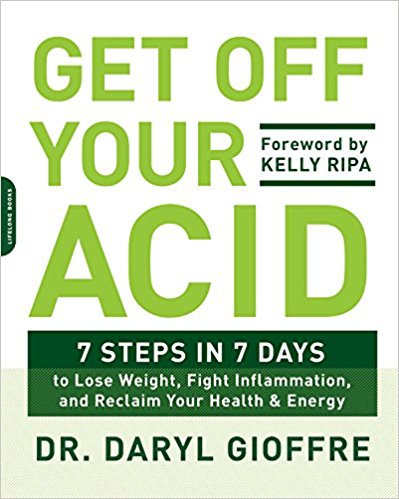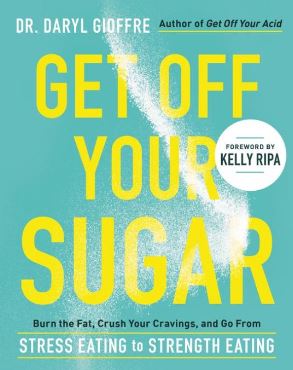 If you’re trying to GET OFF YOUR ACID now that the New Year is here, you probably have a lot of questions about the alkaline lifestyle.
If you’re trying to GET OFF YOUR ACID now that the New Year is here, you probably have a lot of questions about the alkaline lifestyle.
Once you get going, it’s not difficult to maintain – unlike most crash diets – but it does have a little learning curve…
And that’s what we’re going to tackle today!
I’m answering all your toughest questions – and the ones I hear most often.
If I don’t get to yours, leave it in the comments below and I’ll do my best to answer every last one of them.
Okay, let’s dive right in…
- I thought you can’t change the pH of your blood. So why does it matter what the pH of your food or water is?
This is a great question and a common misconception about the pH of our bodies.
As you know, there are certain numbers that the body has to maintain within a very tight range to be healthy and to stay alive.
Temperature should be 98.6, blood pressure at 120/80, ideal cholesterol between 200-240, and so on.
Well, there’s another number you need to know about, that your doctor is most likely NOT talking about – blood pH.
The human body thrives when it maintains a slightly alkaline blood pH. The pH scale goes from 0-14, where 0 is pure acid (burning a hole through steel), and 14 is pure alkaline. 7 is neutral.
The pH of our blood ALWAYS regulates itself at 7.4, and that will never change. So the purpose of eating and drinking alkaline is not to try and raise the pH of your blood like so many people think.
The whole purpose of eating and drinking alkaline is to prevent the body from having to do so much regulating ON ITS OWN.
Your body will do whatever it needs to regulate a constant pH of 7.4, and that is where the problem lies.
If you’re eating foods with a very low pH, like fried foods, soda, and sugary foods, plus if you’re stressed or not getting adequate rest, your body will ‘rob Peter to pay Paul’ to maintain that healthy pH level of 7.4.
In other words, it will deplete its own resources and mineral reserves to neutralize all that acid to tightly regulate and maintain its healthy blood pH level.
The body will pull minerals from saliva, muscles, and – the biggest source – bones in order to keep the blood slightly alkaline. And you’ll have less energy and weaker bones and muscles as a result (amongst other bad things).
Think of what you eat like a scale. Alkalizing foods (mainly organic greens and low-sugar fruits) all score well ABOVE 7.0. Just about everything else we eat (sugar, soda, processed grains, meat, dairy, coffee, bread, pasta, etc.) score UNDER 7.0.
So what does your pH scale look like? Is it tipping to one side or another? Is it over 7? Under 7? And what is your body doing to compensate for that number?
- Is (fill in the blank food) acidic or alkaline?
This is one I’m asked all the time. As you’re adjusting to the alkaline lifestyle, you’re going to come across different foods that you’re not sure where they fall on the pH scale.
You can make an educated guess, which I’ll tell you more about, or you can download our free guide to hundreds of foods.
My Ultimate Alkaline/Acid Food Guide with 550 foods is a great resource that you can keep on your phone or print out and carry with you. Download it now.
If you don’t have that on hand, you can figure out how alkaline or acidic a food is as an estimate. All you need to know is this:
More Sugar = More Acid More Minerals = More Alkaline
So think about a food like pizza. It’s high in carbs, but also very low in minerals. So it’s acidic. It also contains trans-fats and plenty of the pro-inflammatory Omega-6 fats.
Then consider a smoothie. It’s probably fairly high in sugar if you’ve added fruit, but it’s also very high in minerals from the fruit, as well as the greens and healthy fats you’ve put in. So it’s mildly alkaline.
Finally, think about a veggie like broccoli. It’s low in sugar, and very high in minerals, so it’s highly alkaline.
You can probably guess the alkalinity or acidity of any food just based on that framework. But feel free to ask too – we’re here for you as a resource.
- How can I get enough protein?

When you’re just starting to GET OFF YOUR ACID, it can seem like you’re taking away all of the protein in your diet. And for many people, going alkaline does mean significantly reducing the types of proteins they used to eat.
The good news is you can replace meat with plenty of alkaline proteins. But before we run through those, it’s worth considering how much protein you really need.
Think for a second about the largest land animals on earth – elephants, hippos, gorillas, cows, giraffes, rhinos – these are powerful animals, right? And what do they eat? Vegan diets rich in alkaline vegetables!
Now you might be thinking, “Sure, but those are animals. They’re herbivores and their metabolism is different, and they use different enzymes, etc. I’m an omnivore.” And all that’s true.
But did you know that many of the top athletes in the world like Venus William also eat a plant-based diet these days? And they report that it makes them faster, stronger, and more energetic.
That might be because most Americans are getting far too much protein, which drags them down and leads to weight gain, bone loss, and even the growth of cancer cells.
If you’re eating an 80/20 alkaline diet like pro-football star Tom Brady does, you’re going to be getting plenty of protein.
Remember, you can use the 20% of your plate for acid-forming foods for animal protein sources if you choose. I just encourage you to make wise choices, like wild-caught fish, organic poultry, and free-range beef.
Otherwise, stick to alkaline proteins like:
- Hummus/ chickpeas
- Beans (smaller beans, soaked and sprouted)
- Raw almonds or almond butter
- Chia seeds
- Sunflower seeds
- Quinoa
- Ezekiel bread (in moderation)
- Lentils
- Peas
- Spinach and other dark, leafy greens
- Why are some acidic fruits okay, like lemons, when others, like oranges, aren’t?
 This is another common misconception about acidic foods. We think of lemons, limes, grapefruit, and oranges as acidic.
This is another common misconception about acidic foods. We think of lemons, limes, grapefruit, and oranges as acidic.
And often, doctors will tell patients to avoid these acidic foods.
But some of these acidic foods are actually highly alkaline once they get inside your body.
To explain why, let’s remember the acid equation…
More Sugar = More Acid More Minerals = More Alkaline
So in the case of lemons, they are low in sugar, and high in minerals. So they are alkaline-FORMING.
In the case of oranges, however, they are high in both sugar and minerals, so they are moderately acid-FORMING.
Why does the sugar “win” out, trumping the mineral content? Because sugar is like glue for your insides!
So don’t worry about the pH of food outside your body – it’s what it does to you once it’s metabolized inside that counts.
Now just as a reminder, you can eat oranges if you love them! Like all acidic fruits, they do have great vitamins and minerals that make them worthwhile. Make sure they are in season, and limit these types of fruit to no more than one or two daily. But you need to balance the sugar with alkaline foods.
So a smoothie made with oranges, greens like spinach, and a couple of healthy fat sources like coconut oil and chia seeds make a great way to enjoy oranges. But please don’t drink OJ, as the fructose levels in the juice are substantially higher than soda.
- Can’t I just take over the counter multivitamins or calcium supplements for all the minerals I need?
If I could shout this from the rooftops, I would… NOT ALL MINERALS ARE CREATED EQUAL!
The problem with most vitamins and supplements in general is that they use the cheapest forms available.
Let me ask you, how do you think they get the calcium to put in a supplement, whether it’s a multivitamin or a buffer like Tums?
Many companies use calcium carbonate which is a very cheap and even dangerous form of calcium. First and foremost, 25 of the American population can’t absorb this form of calcium, and those that do, it goes to the WRONG places.
Instead of going to your bones to make you stronger, they land in your blood vessel walls and cause plaquing, or wind up in your joints creating arthritis.
Not only that, but most supplements don’t balance minerals in the proper ratio, which can actually be dangerous to your health! Make sure your good quality supplements supply calcium and magnesium in a 1:1 ratio, in order to keep your heart healthy.
Additionally, the delivery system has so much to do with bioavailability of the supplement. 10-30% of tablets get absorbed, and capsules a little better, at 50%. That is why I prefer mineral powders, as the absorption rate is close to 100%.
 Alkamind Daily Minerals will deliver the proper ratio of 4 essential minerals – magnesium glycinate (the most absorbable form of chelated magnesium), calcium citrate (1:1 ratio), potassium bicarbonate, and sodium bicarbonate – from the highest quality, bio-available sources.
Alkamind Daily Minerals will deliver the proper ratio of 4 essential minerals – magnesium glycinate (the most absorbable form of chelated magnesium), calcium citrate (1:1 ratio), potassium bicarbonate, and sodium bicarbonate – from the highest quality, bio-available sources.
It will improve your sleep, fight acid reflux, help you focus, and keep your muscles, bones, and joints at their best.
Order your copy of Dr. Daryl’s new book, Get Off Your Acid, 7 Steps in 7 Days to Lose Weight, Fight Inflammation, and Reclaim Your Health and Energy today!
Easy, customizable plans (2-day, 7-day, and longer) to rid your diet of the acidic foods (sugar, dairy, gluten, excess animal proteins, processed foods) that cause inflammation and wreak havoc on your health.
Let’s talk about the four-letter word that’s secretly destroying your health: ACID. An acidic lifestyle–consuming foods such as sugar, grains, dairy, excess animal proteins, processed food, artificial sweeteners, along with lack of exercise and proper hydration, and stress–causes inflammation. And inflammation is the culprit behind many of our current ailments, from weight gain to chronic disease. But there’s good news: health visionary Dr. Daryl Gioffre shares his revolutionary plan to rid your diet of highly acidic foods, alkalize your body and balance your pH. With the Get Off Your Acid plan, you’ll:
- Gain more energy
- Strengthen your immune system
- Diminish pain and reflux
- Improve digestion, focus, and sleep
- Lose excess weight and bloating, naturally
With alkaline recipes for easy, delicious snacks and meals, Get Off Your Acid is a powerful guide to transform your health and energy–in seven days.
 Skip to content
Skip to content







